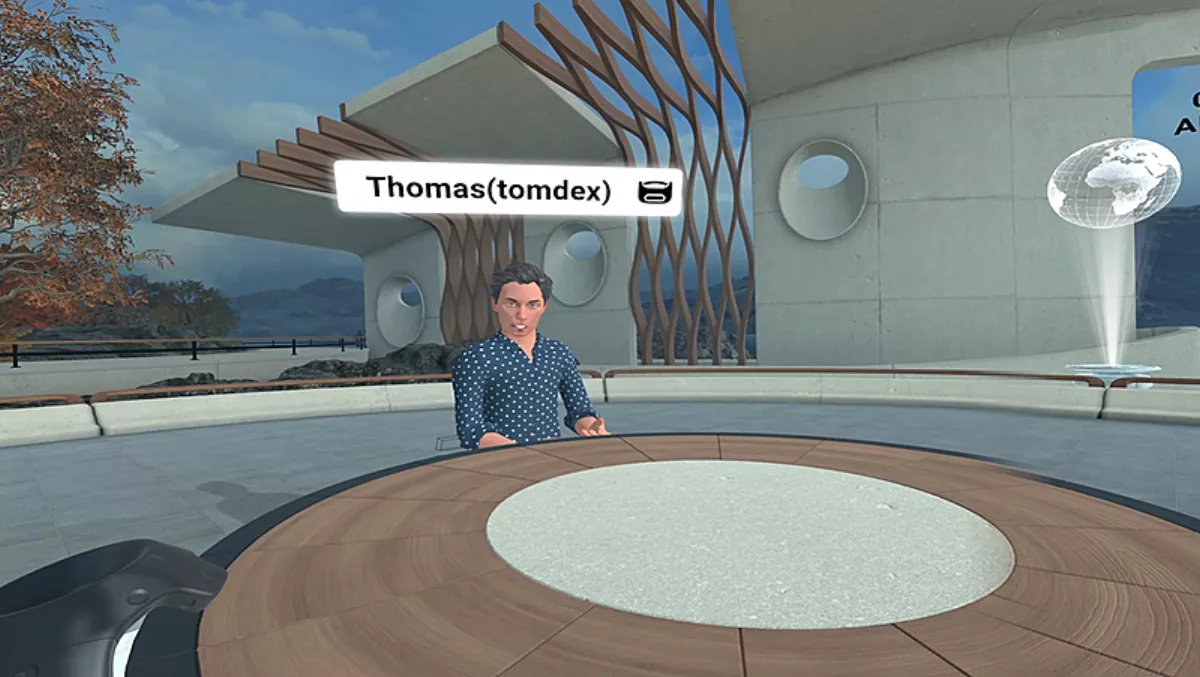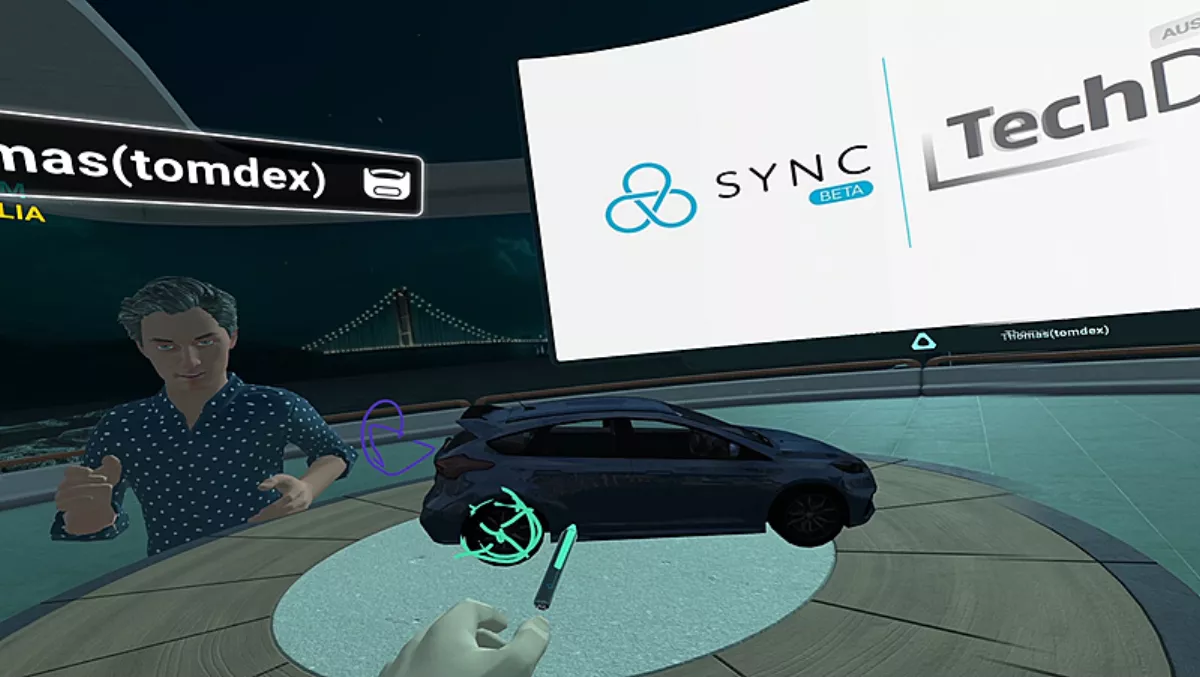
HTC’s Vive Sync VR meeting app enters open beta
HTC have opened up the beta of their new virtual reality meeting app, Vive Sync. Owners of Vive VR kits can now try out this new virtual meeting space for free.
Teams are working remote from one another more and more often. In some cases, they are never likely to meet face-to-face. We now seem to exist in a world of disconnected teleconferences and badly put together webinars. We are losing out on the physical connection with our teams, our presenters and our audiences.
Surely, we can do better than grainy video calls and poorly narrated PowerPoint presentations?
Virtual meeting spaces are not new. I remember many an evening, back in the early '00s, gazing out on the Desert of Marr chatting away in the original Everquest. Then there was Second Life, and the release of a billion MMOs.
We've come a long way. Now we've live concerts in Fortnite and social VR games like Wolf Among Us and even Star Trek Bridge Commander. This is all very well, but anyone that's visited your average shared virtual space, being VR or not, will know that it's not very corporate, unless party hats are the dress code in your boardroom meetings.
I recently had a meeting with Thomas Dexmier, HTC Vive ANZ country manager, within HTC's new Sync virtual reality meeting application.
I'm not going to lie, PlayStation VR aside, consumer VR is a bit of a mixed bag. There are occasions when my Vive decides to just not play ball. OK, a simple restart will sort it out, but what I'm saying is there are plenty of things that can go wrong. New initiates to video-conferencing will know what I mean with video and microphone issues being order of the day.
Vive Sync, however, worked without a hitch.
Delegates new to the VR meeting platform need to download the Vive Sync mobile app. Using the mobile app, users can create an avatar, based on a selfie-shot, to be their personification within the VR meeting. Completed avatars are given a code which can be added to the Vive profile required to launch the meeting. There are, however a selection of pre-made avatars to use in for those without the time to mess about.
Users familiar with other telemeeting applications will be familiar with the room code and password required to enter a meeting. As this is a more interactive environment, participants can link a OneDrive folder to their HTC profile for saving documents and storing presentation materials.
Just as in real life, I turned up ten minutes early for the VR meeting. Partially due to the very British "never be late to a meeting ethos" and also to make sure everything worked OK.
The first thing that I noticed was my shadow, or rather my avatar's shadow. Looking down, I could see my feet. My Vive controllers were resting in hands attached to arms. I was present and not just a pair of disembodied controllers floating in space.
The meeting area was one of three available at this time, on a structure surrounded by ocean and the city San Francisco in the background. Peering over the edge of the circular meeting area I could see, and hear, waves lapping. The other spaces allow meetings to be held in the clouds or in a futuristic sci-fi environment.
Dead on time, Thomas Dexmier's avatar appeared. I'd met Thomas before and recognised his avatar. He complimented me on the accurate likeness of my avatar to me in real life. It was nice him to say, if polite, as Sync is rather flattering when it comes to depicting waistlines. I did think, Thomas being a lot taller than me, that I should have, perhaps, added a few inches to my height.
It's worth noting that Sync is not a game. It's not a VR "social space". That's not to say it can't be used as one. It is clearly a corporate tool, a cool one, but a corporate tool, nevertheless. In creating my avatar, was not presented with the opportunity to don a fancy hat or a gorilla suit.
Movement in the meeting space is via teleporting. I immediately teleported a bit too close to Thomas, and certainly far too close for social distancing.
We greeted each other with my first virtual handshake, possibly the only way I'll be doing handshakes from now on. It was amazing just how much additional communication, with only Thomas' controllers and head movements being replicated by his avatar, this extra body language imparted over that of a floating head on a webcam display.

Sync interpolates a lot of the information like lip-syncing and eye movements, as well as the inverse kinetics for legs and arm positions. With the eye-tracking available on the Vive Pro Eye, eye movements can also be synchronised with the avatar. In time I can see full body movements represented as well as well as fingers using controllers like Valve's Knuckles (which work with the Vive Cosmos Elite).
For now, though, Sync offered an amazing sense of presence. It really felt as if we were both standing there talking to one another.
It was explained that Vive Sync was originally an internal tool devised by Vive Studios to solve the issue of teams working remotely. I noticed that a clock, labelled Australia, was clearly on display to the side of the room. Clocks are provided for each location represented by delegates in the room, so everyone can keep track of the time.
I was then taken through the features of the application. Pressing the index button on my Vive controller brings up a tablet. This can be used to make notes, draw in 3D space, activate a laser pointer and set up the room. Of course, access to this, like the seating allocation can be customised by the host.
Of particular interest was the voice note-taking function. Once activated, public voice communication is muted, allowing users to confidentially dictate notes which are sent to the cloud storage at the end of the session.
Clearly pleased that he had me sucked into his VR world, Thomas upped the ante by making a small round table appear in the middle of the space. He then pulled up a chair and sat down, beckoning me to do the same.
This may be a rather dangerous concept for people unfamiliar with VR. Whilst the tables have allocated positions, you need to remember to sit in a real chair in order to actually sit down. I can see people falling all over the place as they "take a pew".
Whilst I resisted the temptation to rest my elbows on the virtual table, Thomas and myself were sitting opposite each other, just as we would in real life. The tables range from this small table for a few people all the way up to a boardroom table and a 30-seat amphitheatre arrangement.
A PowerPoint presentation was loaded up. A huge cinema-sized screen unfolded at the edge of the space and day turned to night. It was pretty impressive. Repositioning himself, Thomas stood in from of the screen as if presenting. It was easy to see that this was next-level corporate virtual presentation technology. I can also so this being a great way to carry out remote training and even teaching.
Back at the table, a 3D model of a car was loaded in front of us, as if we were looking at a product for evaluation. I can see just how easy it could be to explain an idea to colleagues by interacting up close with a 3D design.

Back on the big screen, I watched a Vive Sync video presentation. I could have watched a movie on the screen; it was so clear. And, of course, as I was using the Vive Cosmos, the display was crisp and without any real sign of the dreaded screen-door pixel effect.
For his final trick, Thomas bought up the amphitheatre seating. Repositioning myself on my chair at the back of the seating, I could easily imagine being surrounded by other virtual delegates, some of which I'd recognise from the avatars, a give them a wave.
As well as the sense of being in an actual space, having the ability to observe subtitle body-language and seeing avatar's lips moving in sync, voices are positioned three-dimensionally, as well. This means if someone is talking to you from the left, they sound like they are to the left. This would make virtual conversations with multiple participants much more natural.
My only concern would be the reluctance of non-technical people in putting on the headset and entering this virtual space. Thomas Dexmier was preaching to the converted with me. I'm all over this sort of stuff. Some people may need some convincing. Although the software is still in beta, it works very well. So technically, I don't see there being any issue with uptake.
At the moment, Vive Sync is open during the beta period. In the long run, there will be a subscription, likely on a per seat basis. Whilst I'd imagine that Vive Sync will not be the only product of this type in the months to come, they've certainly got a head start and robust foundation in place.
As well as bringing remote teams together, I can see virtual trade shows and conferences on the horizon. CORVID-19, aside, from a sustainability and logistical point-of-view, bringing people together in a virtual reality environment does make sense.
As VR headsets get lighter, more advanced and easier to use, the likes of Vive Sync are going to become more and more commonplace. I witnessed the birth of the massively multiplayer online game with MUD in the early eighties and debated the plot of Blade Runner on the newsgroups that would become the Internet, a few short years later. My experience with Vive Sync gave me a similar taste of what's in store for us in the future.
HTC Vive owners can all sign up and use the Vive Sync open beta right now. Forget Zoom, this is the future of online meetings.


